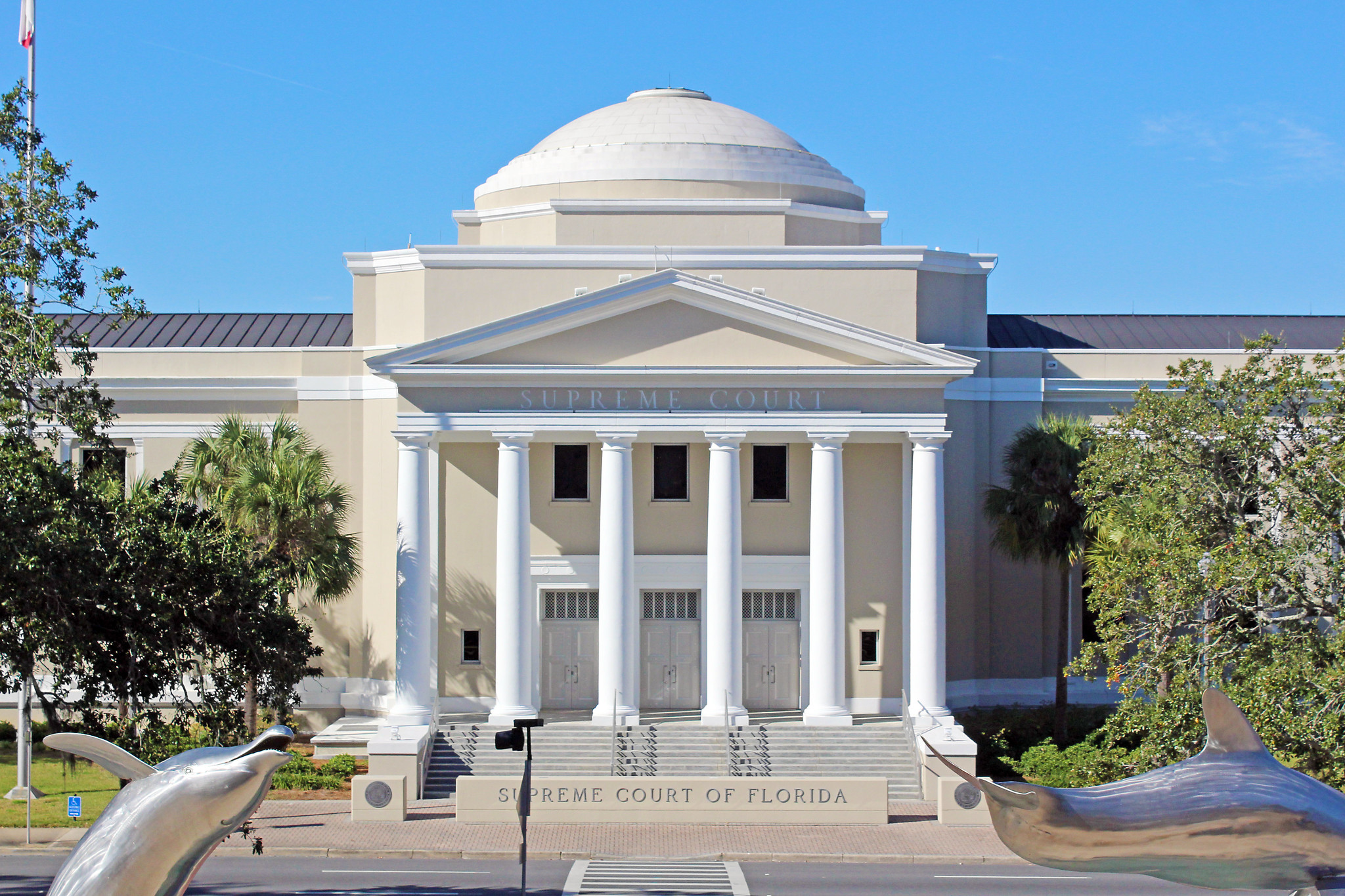Defining Voter Intimidation: Six Battleground States
How do six battleground states define and attempt to prevent voter intimidation?

Published by The Lawfare Institute
in Cooperation With

Lawfare is partnering with the Stanford-MIT Healthy Elections Project to produce a series on election integrity in the midst of the coronavirus crisis. The Healthy Elections Project aims to assist election officials and the public as the nation confronts the challenges that the coronavirus pandemic poses for election administration. Through student-driven research, tool development, and direct services to jurisdictions, the project focuses on confronting the logistical challenges faced by states as they make rapid transitions to mail balloting and the creation of safe polling places. Read other installments in the series here.
The specter of voter intimidation in the 2020 election has received renewed attention recently, in part due to the president’s directive in the first presidential debate for his supporters to “go into the polls and watch very carefully.” People have made concrete allegations of voter intimidation in Minnesota, Virginia, North Carolina and Michigan. But different media outlets and analysts often define voter intimidation in different ways. It’s even more important to clarify what constitutes voter intimidation as Election Day inches closer.
Federal law defines voter intimidation in broad strokes as acts that “intimidate, threaten, or coerce, or attempt to intimidate, threaten, or coerce any person for voting or attempting to vote.” Little official federal guidance exists as to what particular conduct that definition covers. However, according to the Brennan Center, it may encompass:
- Baseless or abusive challenges to voters’ eligibility.
- Direct confrontation of voters.
- Use of insulting, offensive, or threatening language or raised voices in and around polling places.
- Blocking polling-place entrances. ...
- Brandishing weapons in front of voters.
- Dissemination of misleading election information.
Similar to federal law, many state laws about voter intimidation are broad and often fail to provide guidance as to which particular acts would constitute a violation. And because instances of voter intimidation have rarely made it into the courts, there’s a dearth of case law that could illuminate how states’ broad prohibitions might apply in particular instances.
This post sheds light on the rules and guidance aimed at preventing voter intimidation in six battleground states: Arizona, Florida, Michigan, North Carolina, Pennsylvania and Wisconsin. It does not seek to provide a comprehensive assessment of remedies for alleged voter intimidation, nor does it explore the legal prohibitions on related conduct, such as electioneering. While Pennsylvania enumerates specific examples of what conduct constitutes voter intimidation, most states we examined did not, leaving it an open question how state officials may apply their broad prohibitions against such conduct.
Arizona
Arizona law includes both general prohibitions on voter intimidation and more specific protections for certain groups. In Arizona, it is a misdemeanor for an individual to “make use of force, violence or restraint,” “inflict or threaten infliction ... of any injury, damage, harm or loss,” or “in any manner to practice intimidation upon or against any person,” to influence whether that person votes or for whom they cast a ballot. Arizona law also makes voter intimidation by employers illegal. Section 10-1012 states that it is a misdemeanor for an employer to put employees’ pay in envelopes with “political mottos, devices, or arguments” aiming to influence employees’ political views or behavior. In addition, within 90 days of an election, an employer may not exhibit any notices, handbills or placards that contain election-related threats—this prohibition includes statements that if a particular candidate is defeated, wages will be lowered or the establishment will close.
Arizona law also includes broader protections intended to provide bulwarks against voter intimidation. First, Arizona requires a 75-foot zone to be maintained around voting areas, in which only poll workers and individuals currently voting are permitted. It is a misdemeanor for a voter to “interfere with [another] voter” within this 75-foot limit, or within 75 feet of a main outside entrance to an on-site early voting location. Voters also may not “hinder the voting of others.” They may not “by force, threats, menaces, bribery, or any corrupt means ... awe, restrain, hinder, or disturb” electors, or deter them from or influence them in casting their vote. Additionally, it is a felony to interfere with election officers.
These provisions exist against the backdrop of a long history of voter intimidation in Arizona. Minority voters have been frequent targets of intimidation efforts in Arizona. According to an expert report submitted in a case decided by the U.S. Court of Appeals for the Ninth Circuit:
Intimidation of minority group members ... who wished to vote was ... a fact of life in Arizona [in the 1960s]. [White voters] sometimes challenged minorities at the polls and asked them to read and explain “literacy” cards containing quotations from the U.S. Constitution. ... People in the non-Native American community, hoping to keep Native Americans away from the polls, told them that involvement could lead to something detrimental, such as increased taxation, a loss of reservation lands, and an end to their special relationship with the federal government.
Intimidation of these communities has continued since the 1960s. The Arizona Native Vote Election Protection Project has documented instances of voter intimidation of Native American voters at Arizona’s Guadalupe polling station in 2008 and 2010. In 2014, the Department of Justice considered the threat of voter intimidation in Arizona likely enough to warrant monitoring the area.
Despite this history, few Arizona state court decisions have addressed voter intimidation. In the 1948 case Morgan v. Board of Sup’rs, an individual sought to invalidate the results of a referendum concerning school bonds. Among other claims, the plaintiff argued that acts of intimidation by election officials and school trustees compromised the election’s fairness. These officials and trustees allegedly distributed documents stating that voters needed to pay property tax to vote, and forced voters to answer questionnaires about this before voting. The Arizona Supreme Court found that the presence of such conduct was not sufficient to contest the election. The court noted that the evidence failed to show “any appreciable number of qualified voters excluded or any act of intimidation or coercion.” This case illustrates the high bar for proving voter intimidation in Arizona courts. While the court found that the alleged suppressive conduct occurred, it also required plaintiffs to prove its intimidatory impact on an appreciable number of voters.
At least one case in federal court has considered Arizona’s voter intimidation statutes. There, the Arizona Green Party argued that certain candidates were placed on the ballot solely to draw votes away from the Democratic Party and requested a temporary restraining order to prohibit those candidates from being listed. When the plaintiff raised Arizona’s criminal prohibitions against voter intimidation, the U.S. District Court for the District of Arizona stated that it “was not persuaded” those prohibitions could be raised by a private party. Instead, bringing those claims required some indication that the legislature “intended to protect any special group by creating a private cause of action by a member of that group.” These plaintiffs failed to make that showing, but future litigants potentially could.
Florida
Florida statutes outline some actions that constitute felony voter intimidation. Under Fl. §104.0615, it is a felony for any person to use or threaten to use force, violence, or intimidation to induce someone else to:
- Vote or refrain from voting altogether or for a specific candidate or measure.
- Register to vote.
- Become a poll worker or watcher.
- Challenge a person’s right to vote.
Florida also has laws that tangentially cover voter intimidation. These include laws banning photography and electioneering within 150 feet of polling locations. Election officials are also tasked with enforcing order at polling locations and may take “reasonable steps” to do that, including having law enforcement remove disturbances.
In recent years, voter intimidation in Florida has made the news repeatedly. During early voting for the 2016 presidential election, the Lawyers’ Committee for Civil Rights Under Law said it received reports about aggressive behavior causing voters to leave the polls without voting. During the 2018 midterms, NPR reported that a white supremacist group in Iowa used racist robocalls with derogatory and offensive language in order to disparage Florida gubernatorial candidate Andrew Gillum in an attempt to dissuade electors from voting. And in February 2019, robocalls claiming to be from the Palm Beach County Supervisor of Elections Office warned voters about the penalties of vote-by-mail fraud. The county election supervisor reported the incidents to the state attorney general, citing the potential for the robocalls to “frighten and intimidate voters.”
Michigan
In Michigan, it is a felony to, “influence, deter, or interrupt an elector while they’re giving their vote” using “bribery, menace, or other corrupt means.” While the law itself does not specify prohibited behavior, Michigan’s Bureau of Elections released guidance explaining that poll watchers and election challengers are forbidden from approaching or talking to voters for any reason. If one of these people violates this standard, election officials can ask them to leave. If they refuse, the election inspector “will call law enforcement.” And although challengers are allowed behind the processing table, they must give precinct workers ample space to perform their duties and may not hinder voters in any way. There are also rules limiting how election challengers may dispute individual voter registrations. Challengers may contest the registrations of voters, but challengers must not do so indiscriminately so as to avoid voter intimidation. For example, challengers may not challenge an elector’s registration based on “impressions” —including ones based on the elector’s manner of dress, race, disability, inability to read English, need for assistance or lack of picture ID. Any challenger found to have challenged a qualified and registered elector for the purposes of annoying or delaying their vote could be found guilty of a misdemeanor.
Voter intimidation in the 2020 election in Michigan has already occurred. On Oct. 1, Michigan’s attorney general charged two political operatives with voter intimidation for orchestrating a series of robocalls to suppress the vote in the November general election. These robocalls presented misleading information about mail-in voting, including claims that personal information submitted on mail-in ballots could be used to execute outstanding warrants or to collect unpaid debts. This was not the first instance of alleged voter intimidation in Michigan. In 2016, the Michigan Democratic Party alleged that the state’s Republican Party and the Trump campaign were conspiring to prevent minorities from voting. In their complaint, they cited pledges by Trump supporters “to descend upon polling places in ‘certain areas’ where many minority voters live in order to interfere with their efforts to exercise the franchise.”
North Carolina
North Carolina state law prohibits intimidating legally qualified voters. Any attempt at voter intimidation is a Class 2 misdemeanor. Although the statute does not provide an explicit definition of intimidation, the State Board of Elections provides examples of conduct that may unlawfully intimidate voters, including:
- Approaching voters who appear to be of a certain ethnic group to ask whether they speak English or to demand they verify their citizenship.
- Following a non-English speaker and accusing them of committing voter fraud.
- Yelling insults or profanity at people who received voting assistance.
More broadly, North Carolina law forbids engaging in “disruptive behavior” that may interfere with voting, deterring voters from exercising their rights, photographing or filming inside the polling place without consent, or hindering access, harassing others, as well as engaging in election-related activity within the buffer zone designated by county boards of elections around polling locations. North Carolina law also includes provisions dictating election officials’ and poll monitors’ responsibilities to prevent voter intimidation. Chief judges of polling places are responsible for maintaining order at polling places, including preventing voter intimidation. If necessary, they may call the police for aid. Election observers may not interfere with voters under any circumstances, participate in electioneering or attempt to challenge voters without a proper basis.
In spite of these directives, voter intimidation remains a concern in North Carolina. On Feb. 24, the NAACP called for emergency action regarding voter intimidation. The NAACP letter responded to an incident where demonstrators displayed flags supporting the Confederacy, the League of the South and President Trump near an early voting site. During the 2018 midterms, election officials removed a poll worker from an early voting site for alleged voter intimidation after the worker repeatedly asked several African American voters to spell their names.
Pennsylvania
Pennsylvania law dictates that no person shall, by intimidation, “intentionally prevent or attempt to prevent an applicant who is a qualified elector from being registered or a registered elector from changing political enrollment.” Per the Pennsylvania Department of State, it is illegal to:
- Practice intimidation or coercion through the use of force, violence, restraint, or infliction or threatened infliction of injury, damage, harm, or loss, in order to induce or compel a person to vote or refrain from voting for a particular candidate or on a particular political issue[.]
- Use abduction, duress, coercion, or any other forcible or fraudulent means to impede, prevent or otherwise interfere with a person’s right to vote.
Individuals who intimidate voters can be fined up to $5,000 and face up to two years in prison. Each county commission is required to investigate alleged violations and report them to the district attorney, who has the authority to prosecute such violations.
The Pennsylvania Department of State published nonbinding guidance listing examples of voter intimidation. These examples include aggressive behavior outside the polling place, blocking the the entrance, confronting or questioning voters, disrupting voting lines, disseminating false or misleading election information, displaying weapons, photographing or videotaping voters, using raised voices or insulting or threatening language inside the polling place, vandalism of polling places, and verbal or physical confrontation of voters by persons dressed in official-looking uniforms.
Pennsylvania law also includes provisions regarding the conduct of election officials and police officers on Election Day. Any “registrar or clerk who, without reasonable cause, refuses to register a qualified elector lawfully entitled to be registered commits a misdemeanor of the first degree.” The Pennsylvania Department of State further prohibits poll watchers from confronting, hovering or speaking to voters, posting signs inside the polling place about penalties for “voter fraud,” and challenging voters without a good-faith basis. If necessary, a commission may call police officers to maintain the peace at a place of registration. However, police are otherwise banned from coming within 100 feet of the polling place and may not practice “any intimidation … nor, in any manner, unduly influence or overawe any elector or prevent him from voting or restrain his freedom of choice.”
As a result of President Trump’s comments during the presidential debate encouraging supporters to go to the polls in Philadelphia and “watch very carefully,” the mayor of Philadelphia vowed to develop an interagency plan to combat voter intimidation. This development comes amid allegations that communities of color faced voter intimidation during the Pennsylvania primary and as Pennsylvania’s attorney general investigates robocalls telling voters that information they use to vote will be used to issue arrest warrants and collect unpaid debts.
Wisconsin
Wisconsin law defines voter intimidation broadly, stating that “[n]o person may personally or through an agent, by abduction, duress, or any fraudulent device or contrivance, impede or prevent the free exercise of the franchise at an election.” Further, the statute prohibits the use or threat of violence, kidnapping, or any form of force to compel someone to vote a certain way or abstain from voting. Wisconsin also has laws aimed at minimizing the risk of voter intimidation, including rules that ban electioneering within 100 feet of polling locations and allow police officers to enforce the anti-harassment of voters at the discretion of election officials. Wisconsin law authorizes election officials to remove individuals causing a disturbance and move the polling location if it is “impossible or inconvenient” to continue holding the election in its original location. Finally, the Wisconsin Board of Elections provides an anonymous form to submit instances of voter intimidation.
But the applicability of these statutes to voter intimidation through misinformation in Wisconsin is unclear. While Wisconsin law bans the use of “fraudulent devices or contrivances” to suppress voters, it does not define the term.We found no case law in Wisconsin elaborating on the subject. This ambiguity is particularly worrisome because this type of voter intimidation has occurred recently. In 2004, a nonexistent “Milwaukee Black Voters League” distributed flyers in predominantly minority communities containing false information about the ability to vote, including claims that violations were punishable by 10 years in prison. In 2010, billboards advertising the penalties for voter fraud, but providing no voting information, appeared in predominantly minority communities. Unfortunately, it’s hardly clear whether Wisconsin statutes are sufficient to handle all such permutations of voter intimidation.
Conclusion
- The six battleground states we examined differ in what particular conduct they identify as intimidating. For example, while Florida is largely silent on what conduct is disrupting enough to constitute voter intimidation, Pennsylvania provides a comprehensive list of intimidating conduct—including direct confrontation of voters, disrupting voting lines and disseminating misleading election information.
- All six of these swing states prohibit certain types of voter intimidation, such as using force, violence, or threats to influence how or whether electors vote.
- Each state has other election laws aimed at minimizing the risk of disorder and intimidation at the polls, ranging from electioneering buffer zones to prohibiting photography inside polling locations.
- The dearth of recent case law around voter intimidation statutes in these states fails to add clarity to the scope of these prohibitions.
The lack of more specific guidelines about what constitutes voter intimidation in the majority of the states we examined may be problematic given the elevated threat of such conduct in the 2020 election. Many states have already experienced attempts at voter intimidation. States have seen threats made in person at polling locations, along with misleading and even racist robocalls. Without clarity on what conduct is prohibited, such attempts may go unreported or unaddressed, and may lead to litigation over whether a given action constitutes voter intimidation.







